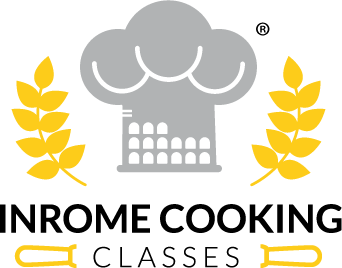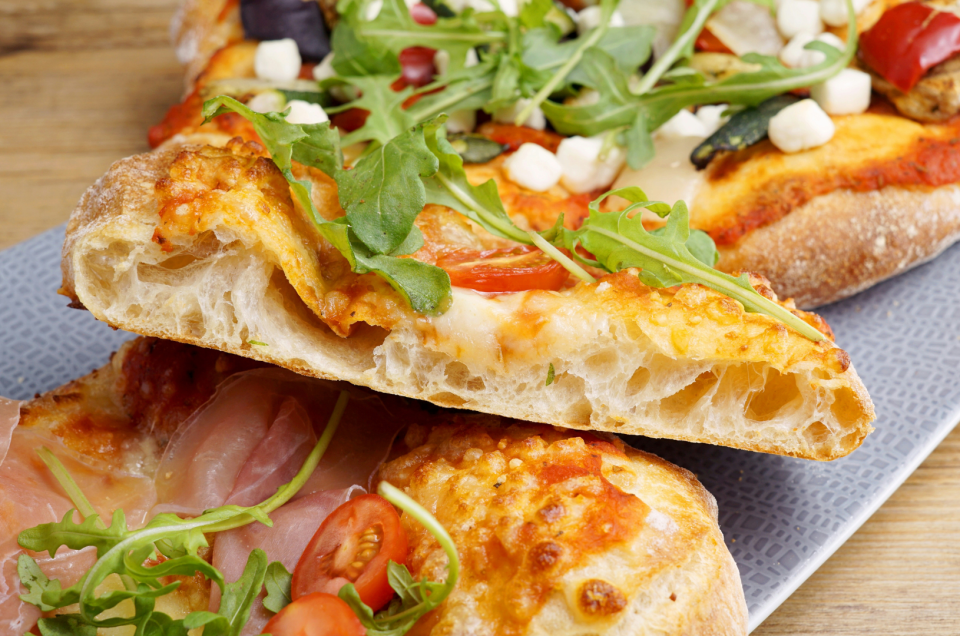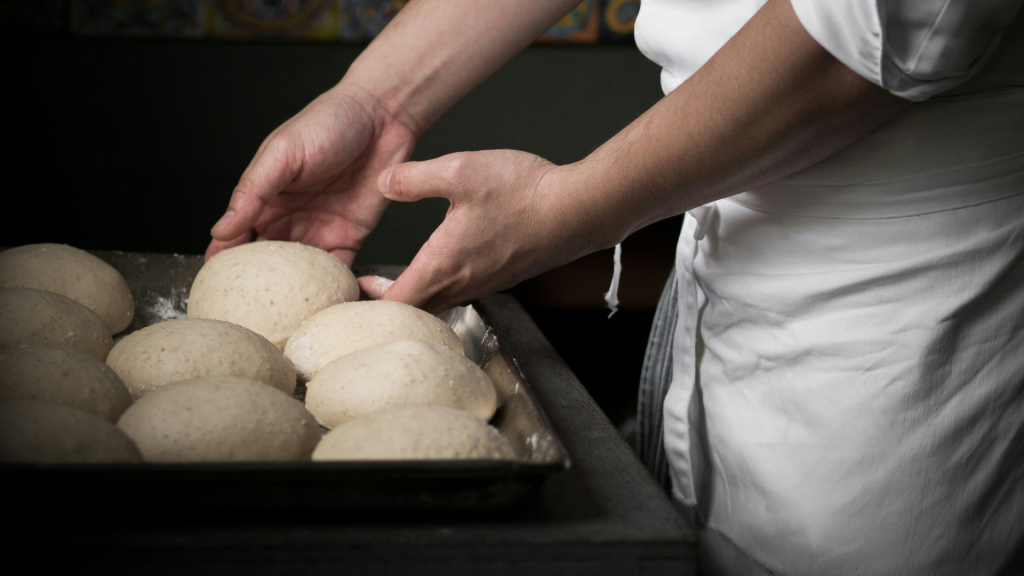Pinsa Romana: everything you need to know
When people come to Rome, usually one thing is on their mind: pizza, pizza, and more pizza! However, upon arrival to the Eternal City, a new player emerges: the mysterious pinsa Romana.
Don’t be fooled by the many pizzeria’s that boast varied pinsas on their menu – pinsa Romana is not pizza. While both are made from a yeasted dough and topped with tomato sauce, cheese, vegetables, or meats, there are a few key differences that set them apart.
Today, we’ll explore the fascinating world behind the pinsa Romana, from its rich history, to what sets it apart from pizza, and finally, how to make your very own pinsa at home.
So, ready your flour and tighten your apron, because it’s pinsa time!
The History of Pinsa Romana
With alleged roots dating back to ancient Roman times, pinsa’s history is as mythical as it is ancient. While some claim it was invented by bakers to test their oven’s heat before beginning their daily baking, other legends suggest that this risen treat was invented by peasants and grilled on an open flame.
However, some claim that la pinsa romana is a remarkably recent invention, possibly being born as late as the 1990s. Whether the pinsa romana is as old as the Roman Forum or young enough to be considered a Millenial, it has undoubtedly made a lasting impression on native Romans, with many of them preferring pinsa’s light texture to pizza’s heavier dough.
Differences Between Pinsa Romana and Pizza
Whichever story you believe, we know one thing for certain: pinsa (sometimes also spelled pinza) is not pizza.
While their toppings may be similar, their base is very different and offers varied textures, flavors, and even health benefits.
Let’s learn what make pinsa and pizza uniquely different!
Shape
The most obvious difference between pinsa and pizza are their shapes.
A successful pizza maker will make their pizzas as perfectly round as possible. This evenly-circular shape is something pizzaiaolos (i.e. pizza gurus) take years to master, using sweeping motions with a rolling pin in every direction to achieve maximum symmetry.
Pinsas, however, aren’t round at all – they’re oval. In fact, the way pinsas name derives from the way it’s shaped. Pinsa derives from the latin pinsere, meaning stretched, as the dough is gently stretched using the chef’s fingertips.
Texture
While the pizza’s 48-hour rising time lends it a fluffy texture, it pales in comparison to the pinsa’s airy dough which is fermented for 72 hours.
Pizza dough contains white sugar and is made from 0 flour, pinsa dough is sugar-free and made from a mix of rice, soy, sourdough, and wheat flours. This special flour is yeasted and mixed with cold water, aerating it further and producing a remarkably fluffy texture with a crunchy crust.
Because pinsa is typically thicker than pizza, this can make it seem denser and more filling, with Roman pizza usually being thin crust.
Flavor
Most Italians would describe pizza crust as having a light, wheaty flavor with a slight tinge of olive oil. Meanwhile, the rice, soy, sourdough, and wheat flours lend pinsa a deeper, almost earthy flavor.
Many also say that the sourdough produces a slightly sweet aroma that pairs nicely with the often savory sauces and toppings.
Nutritional value
Contrary to popular belief, pizza is not considered an unhealthy food in Italy as it’s usually made from high-quality ingredients and topped with satiating yet healthy vegetables, meats, and cheeses.
That said, pinsa is the far superior option for health nuts thanks to its rich flour mixture. The sourdough’s fermentation paired with the rice and soy nutrients not only makes pinsa more filling, but also better for you in general.
How to Make Pinsa Romana
Now that you’re an expert on pinsa history and what sets it apart from pizza, it’s time to don your apron and make your own!
Making pinsa dough may be time consuming, but it’s not rocket science. We’ll break down every step into bit-sized instructions that are as easy to digest as pinsa itself.
Let’s get started!
How to Make Pinsa Flour
What truly sets pinsa from pizza is its flour. Unfortunately, finding pre-made pinsa flour can be a challenge, even in Italy.
So, the easiest solution is to make it yourself by combining:
- 50 grams rice flour (about ⅓ cup)
- 100 grams soy flour (about 1 cup)
- 900 grams wheat flour (6 cups – all-purpose flour will also work)
Whisk these flours thoroughly until well-combined and set aside for future use.
How to Make Pinsa From Scratch
Now that your specia pinsa is prepared, let’s get cooking a perfectly fluffy and crispy pinsa Romana!
Many pinserias (restaurants specializing in pinsas) usually ferment their dough for 72 hours, but to make this treat more accessible for those at home, this recipe suggests rising the dough for 24 hours.
This recipe is enough to make two pinsas.
Ingredients:
- 263 grams pinsa flour (1 ¾ cup)
- 1.5 grams fresh yeast (½ tsp – sourdough is traditionally used, but you may need to adjust the measurements)
- 6 grams salt (1 tsp)
- 7 grams olive oil (½ tablespoon) plus more for stretching the dough
- 200 milliliters cold water (about ¾ cup + 2 tbsp)
- All-purpose flour for dusting
Instructions:
- Dissolve the fresh yeast in warm water.
- Fold the yeast mixture into the flour and start mixing it, slowly adding ¾ of the water.
- Once all of the water has been combined, cover the dough with a clean tea towel and set aside for 20 minutes.
- Make a small divot in the middle of the dough and add your salt. Dissolve the salt with the remaining water and continue kneading.
- Add the olive oil to the dough and knead until smooth and incorporated.
- Cover with a towel and let rise for 20 minutes in a warm place.
- Once risen, dump the dough onto an oiled workspace. With oiled hands, gently stretch the dough horizontally, being careful not to tear it. Then, fold all corners into the center until it forms a smooth ball. Cover and set aside for another 20 minutes. Repeat this process two more times.
- After letting the dough rise for the third time, replace the tea towel with plastic wrap and let it rise in the fridge for 24 hours.
- Once the fermentation process is complete, transfer the dough to a floured surface and divide into two equal portions. Shape each portion into a ball, cover and let rise for another 30 minutes.
- Then, stretch each portion out by hand into a rough oval shape. Use your fingers to gently push the dough in either direction.
- Top your pinsa with your desired toppings and pop into a 250°C (480°F) oven for 4 to 5 minutes, or until the crust is golden brown.
Garnish with fresh basil and enjoy!
Pinsa, Pizza, Oh My!
The next time you’re in Rome, swap out your traditional pizzeria dinner for an evening in a pinseria instead. Pinsa’s history may be hazy, but its award-winning taste, enriched nutritional value, and one-of-a-kind texture is crystal clear.
Making pinsas at home is time-consuming, but if done right, you’re in for a homebaked treat like none other. But if you’d rather learn from the pros and master the art of making the perfect pizza, check out our Private Pizza Masterclass – an unforgettable experience in the heart of Rome. Did you know the difference between pinsa and pizzas.






